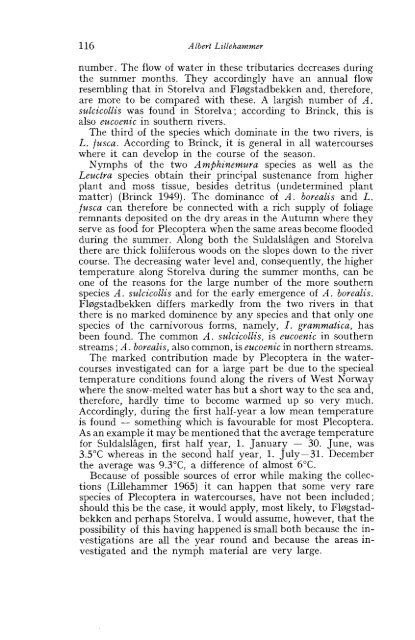NORSK ENTOMOLOGISK TIDSSKRIFT - Norsk entomologisk forening
NORSK ENTOMOLOGISK TIDSSKRIFT - Norsk entomologisk forening
NORSK ENTOMOLOGISK TIDSSKRIFT - Norsk entomologisk forening
Create successful ePaper yourself
Turn your PDF publications into a flip-book with our unique Google optimized e-Paper software.
116 Albert Lillehammer<br />
number. The flow of water in these tributaries decreases during<br />
the summer months. They accordngly have an annual flow<br />
resembling that in Storelva and Fl~gstadbekken and, therefore,<br />
are more to be compared with these. A largish number of A.<br />
sulcicollis was found in Storelva; according to Brinck, this is<br />
also eucoenic in southern rivers.<br />
The third of the species which dominate in the two rivers, is<br />
L. fusca. According to Brinck, it is general in all watercourses<br />
where it can develop in the course of the season.<br />
Nymphs of the two Amphinemura species as well as the<br />
Leuctra species obtain their principal sustenance from higher<br />
plant and moss tissue, besides detritus (undetermined plant<br />
matter) (Brinck 1949). The dominance of A. borealis and L.<br />
fusca daI; therefore bh connected with a rich supply of foliage<br />
remnants deposited on the dry areas in the Autumn where they<br />
serve as food for Plecoptera when the same areas become flooded<br />
during the summer. Along both the Suldalsligen and Storelva<br />
there are thick foliiferous woods on the slopes down to the river<br />
course. The decreasing water level and, consequently, the higher<br />
temperature along Storelva during the summer months, can be<br />
one of the reasons for the large number of the more southern<br />
species A. sulcicollis and for the early emergence of A. borealis.<br />
Fl~gstadbekken differs markedly from the two rivers in that<br />
there is no marked dorninence by any species and that only one<br />
species of the carnivorous forms, namely, I. grammatica, has<br />
been found. The common A. sulcicollis, is eucoenic in southern<br />
streams ; A. borealis, also common, is eucoenic in northern streams.<br />
The marked contribution made by Plecoptera in the watercourses<br />
investigated can for a large part be due to the specieal<br />
temperature conditions found along the rivers of West Norway<br />
where the snow-melted water has but a short way to the sea and,<br />
therefore, hardly time to become warmed up so very much.<br />
Accordingly, during the first half-year a low mean temperature<br />
is found - something which is favourable for most Plecoptera.<br />
As an example it may be mentioned that the average temperature<br />
for Suldalsligen, first half year, 1. January - 30. June, was<br />
3.5"C whereas in the second half year, 1. July-31. December<br />
the average was 9.3"C, a difference of almost 6°C.<br />
Because of possible sources of error while making the collections<br />
(Lillehammer 1965) it can happen that some very rare<br />
species of Plecoptera in watercourses, have not been included;<br />
should this be the case, it would apply, most likely, to Flogstadbekken<br />
and perhaps Storelva. I would assume, however, that the<br />
possibility of this having happened is small both because the investigations<br />
are all the year round and because the areas investigated<br />
and the nymph material are very large.

















